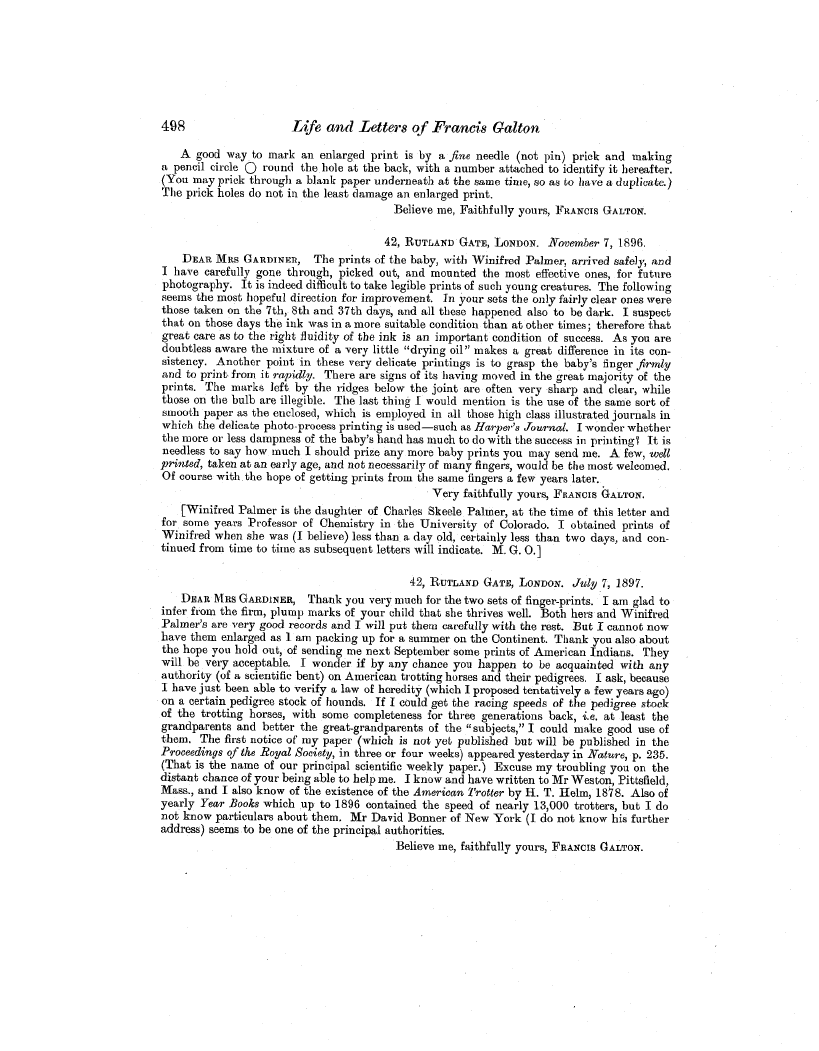| ||||||

OCR Rendition - approximate
498 Life and Letters of Francis Calton A good way to mark an enlarged print is by a fine needle (not pin) prick and making a pencil circle a round the hole at the back, with a number attached to identify it hereafter. (You may prick through a blank paper underneath at the same time, so as to have a duplicate.) The prick holes do not in the least damage an enlarged print. Believe me, Faithfully yours, FRANCIS GALTON. 42, RUTLAND GATE, LONDON. November 7, 1896. DEAR MRS GARDINERR, The prints of the baby, with Winifred Palmer, arrived safely, and I have carefully gone through, picked out, and mounted the most effective ones, for future photography. It is indeed difficult to take legible prints. of such young creatures. The following seems the most hopeful direction for improvement. In our sets the only fairly clear ones were those taken on the 7th, 8th and 37th days, and all these happened also to be dark. I suspect that on those days the ink was in a more suitable condition than at other times; therefore that great care as to the right fluidity of the ink is an important condition of success. As you are doubtless aware the mixture of a very little "drying oil" makes a great difference in its consistency. Another point in these very delicate printings is to grasp the baby's finger firmly and to print from it rapidly. There are signs of its having moved in the great majority of the prints. The marks left by the ridges below the joint are often very sharp and clear, while those on the bulb are illegible. The last thing .1 would mention is the use of the same sort of smooth paper as the enclosed, which is employed in all those high class illustrated journals in which the delicate photo-process printing is used-such as Harper's Journal. I wonder whether the more or less dampness of the baby's hand has much to do with the success in printing? It is needless to say how much I should prize any more baby prints you may send me. A few, well printed, taken at an early age, and not necessarily of many fingers, would be the most welcomed. Of course with. the hope of getting prints from the same fingers a few years later. Very faithfully yours, FRANCIS GALTON. [Winifred Palmer is the daughter of Charles Skeele Palmer, at the time of this letter and for some years Professor of Chemistry in the University of Colorado. I obtained prints of Winifred when she was (I believe) less than a day old, certainly less than two days, and continued from time to time as subsequent letters will indicate. M. G. 0.] 42, RUTLAND GATE, LONDON. July 7, 1897. DEAR MRS GARDINER, Thank you very much for the two sets of finger-prints. I am glad to infer from the firm, plump marks of your child that she thrives well. Both hers and Winifred Palmer's are very good records and I will put them carefully with the rest. But I cannot now have them enlarged as l am packing up for a summer on the Continent. Thank you also about the hope you hold out, of sending me next September some prints of American Indians. They will be very acceptable. I wonder if by any chance you happen to be acquainted with any authority (of a scientific bent) on American trotting horses and their pedigrees. I ask, because I have just been able to verify a law of heredity (which I proposed tentatively a few years ago) on a certain pedigree stock of hounds. If I could get the racing speeds of the pedigree stock of the trotting horses, with some completeness for three generations back, i.e. at least the grandparents and better the great-grandparents of the "subjects," I could make good use of them. The first notice of my paper (which is not yet published but will be published in the Proceedings of the Royal Society, in three or four weeks) appeared yesterday in Nature, p. 235. (That is the name of our principal scientific weekly paper.) Excuse my troubling you on the distant chance of your being able to help me. I know and have written to Mr Weston, Pittsfield, Mass., and I also know of the existence of the American 'Trotter by H. T. Helm, 1878. Also of yearly Year Books which up to 1896 contained the speed of nearly 13,000 trotters, but I do not know particulars about them. Mr David Bonner of New York (I do not know his further address) seems to be one of the principal authorities. Believe me, faithfully yours, FRANCIS GALTON.
|